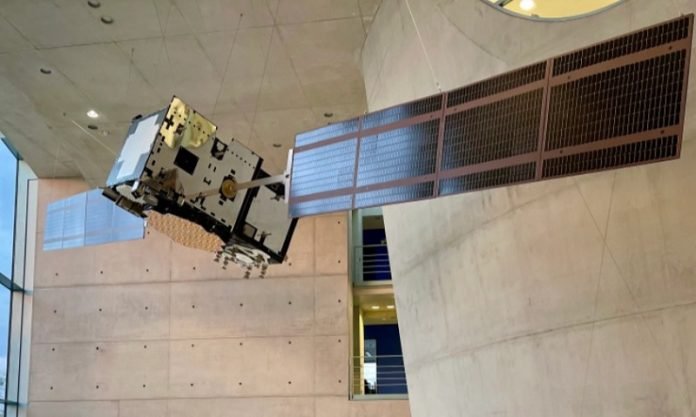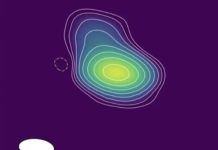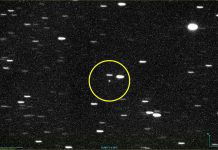
Since the first artificial satellite, Sputnik 1, was launched by the Soviet Union in 1957; the earth-to-space traffic hasn’t stopped.
Numerous technologies are now connected to satellites in some way. André Bauer is working to keep that connection strong.
Imagine watching a rocket that you’d helped design, build, and launch as it hurtles into the pale blue sky above the New Mexico desert.
For André Bauer the sight was transformative, “I don’t think I ever experienced anything like that before because we were the first Australian team to go there.”
The team he’s referring to is the USYD Rocketry Team which gives engineering students hands on experience in building and launching rockets.
At the time of the New Mexico launch, in 2019, Bauer was the team’s elected Executive Director. He’d put his hand up for the role determined to get the team to the Spaceport America Cup to compete in rocketry against other international students.
“I was a couple of years older than the other team members, so I think I could see the opportunity more clearly,” says Bauer who pushed hard for the necessary fundraising and strategized how they might reach their Spaceport goal.
The reason Bauer had a couple of extra years on the team’s other engineering students was because in high school and for some time after, he had pursued his love of the arts, particularly contemporary dance.
“I was really interested in maths and physics but I was also dancing every minute I could,” says Bauer.
“So after high school I went on to the Western Australian Academy of Performing Arts in Perth, studied contemporary dance and performed all around the world. But I always knew that the time would come to pursue other things.”
Indeed, the time to pursue his science interests did come and soon after he found himself in the desert of New Mexico watching the USYD Rocketry Team rocket taking off.
The goal of all the international teams competing was for their rockets to go up 3048 metres (10,000 feet). No higher, no lower. A huge technical feat because of the many variables in play.
The University team not only achieved its 3048-metre goal (the actual recorded altitude was 10,027 feet or 3056 metres), they came first in the challenge and with a record score.
There is online video of the presentation where the winning announcement was made and understandably, the University team is ecstatic with Bauer finding himself dancing for joy.
In 2022, that work is at the DLR Space Applications Institute as part of the Galileo satellite project managed by the European Union Agency for the Space Programme (EUSPA).
Bauer spoke to SAM via Zoom from his current home in Germany though he’s just back from a week in Italy at the Fucino Space Centre (Abruzzo), which hosts part of the Galileo program.
“I did an internship at DLR, the German Aerospace Centre,” says Bauer who has a measured and thoughtful way of speaking. “But I actually learned about the job opportunity through a University of Sydney lecturer who had worked on the Galileo project.”
You don’t have to dig very deeply into the story of the modern satellite industry to realise it’s getting crowded up there.
Modern life’s reliance on satellites
At the end of 2021, there were nearly 5000 active satellites orbiting Earth (plus some thousand inactive satellites). Many, many more are planned.
As they hurtle at thousands of kilometres per hour to prevent being pulled back to Earth by gravity, satellites are also busy making our modern way of life possible.
They might also save the world as they observe global cloud cover, wildfires, volcanoes and smoke, while measuring changes in the oceans, land and air; information that can help farmers maximise food output and scientists to predict weather and our climate change future.
Of the thousands of satellites above us, Bauer’s mainly concerned with those that are part of what’s called the Galileo ‘constellation’. Ultimately, this will see a total of 30 satellites placed above the Earth: 24 operational and six as backup.
Having the job title Ground Segment Operations Engineer, Bauer helps run the on-the-ground infrastructure that monitors and controls the satellite themselves, including the antennas around the world that communicate with the satellites and everything that happens at the control centre.
“We keep the satellites healthy,” he says. “We also do a lot of investigating anomalies and there are times when we have to manoeuvre the spacecraft. It’s all really rewarding work.”
What sets Galileo apart
This is all done to supply what most Australians would call GPS. Though engineers like Bauer would call it Global Navigation Satellite Systems (GNSS).
In fact, GPS (Global Positioning System), is specifically the American equivalent of Galileo, with GLONASS being the Russian and BeiDou being the Chinese. Though there is something that sets Galileo apart.
“Galileo is the only system that is civilian controlled. All the others are, in the first instance, military,” says Bauer. “Satellite global navigation was actually invented by the US military in 1973 and like GLONASS and BeiDou, it must fulfil military objectives first. Galileo is specifically intended to benefit the citizens and the economies of Europe.”
The various satellite systems are all premised on the same idea: placing a network of satellites in positions above the Earth so they can be used for navigation.
To establish the location of a family car or battleship, the object must be in the view of at least four satellites, with more providing greater accuracy.
There is also the need for extremely precise time measurement because to establish the position of an object you need to know how far it is from each of the engaged satellites.
This is calculated from the time it takes for the signal to go from the satellite to the object. Allowing that the signals travel at the speed of light, miniscule inaccuracy in time measurement can lead to massive miscalculations of distance.
“This is one of the big challenges,” says Bauer. “We have to keep Galileo satellites to less than a nanosecond accuracy, keeping in mind that a nanosecond is one billionth of a second.”
Keeping up with rapid industry advancements
Satellite technology has advanced rapidly in recent years, but there are still challenges to overcome.
Back at Bauer’s old stomping ground, the University of Sydney now offers study in spacecraft and satellite design and extensive research is underway to overcome those challenges for the next generation space travel technologies.
This part of a longer term plan to give NSW and Australia a sustained commercial and scientific space industry.
One highly specialised thread of space research at the University aims at producing what’s called a ‘rotating detonation engine’ to replace the current rocket propulsion systems.
To understand why they need replacing, consider the heroic but now-retired Space Shuttle which, like current spacecraft, was driven by an internal combustion engine not unlike what you’d find in a (non-electric) car.
The fuel that was used to get the Shuttle into orbit weighed 20 times more than the actual shuttle vehicle, so it was mostly used to carry itself.
Of course, a massive amount of thrust is needed to lift a vehicle into space, but a rotating detonation engine would generate that thrust in a completely different, lower fuel, way.
The physics of the engine is very complex and even the meaning of the word ‘detonation’ in this context is different from what most people would understand it to mean, but progress is being made and the technology could also make things like commercial, supersonic aircraft more viable.
For Bauer, it is this momentum of discovery that he finds exciting and he remembers being fascinated by flight from a very early age. His eyes are still very much on the sky.
“My focus is changing now from the ground segment to the flight segment as a Spacecraft Operations Engineer,” he says. “That’s my next challenge.”
Written by George Dodd.



